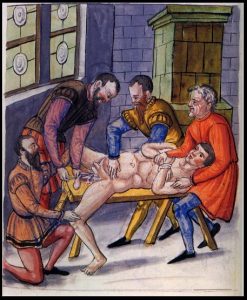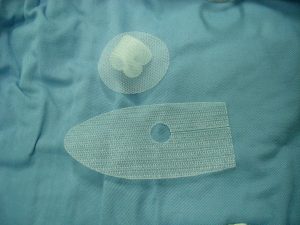 Anybody know what a hernia is and how to get rid of it? Well, I’ll tell ya!
Anybody know what a hernia is and how to get rid of it? Well, I’ll tell ya!
Many think of hernia as something old men get. Reminds me of a TV show that I watched repeatedly years ago. The show was “Cheers” and it followed the gang from the Boston bar where “everybody knows your name.” In one episode, Sam Malone (played by Ted Danson) develops a hernia and he’s struggling since he considers it a condition old men get and it called into question his youthful virility. There must be something with men and aging and our fragile egos. Or so says my wife.
Technically speaking, and I know how smart and techy all you MyHealthyMatters readers are, a hernia is when an organ or other body tissue gets squeezed through a weak spot in the surrounding tissue or muscle. This can happen in lots of places in your body, among them (warning the following few sentences may make you go “ewwww”):
- Intestines poking through a weak part of the abdominal wall (inguinal, umbilical, abdominal hernia).
- Stomach getting pushed through the diaphragm so part of it lands in the chest instead of the abdomen (hiatal hernia).
- Even the brain can herniate, which is a fatal condition in which the stem of the brain gets forced out of the base of the skull due to swelling, inflammation, bleeding, or trauma.
I’m going to focus on the first kind of hernia. I’m doing so because on a recent Healthy Matters broadcast, we had a great discussion about hernias with my two guests, both terrific surgeons at Hennepin Healthcare.
Read on to meet those surgeons, to learn a bit more about hernia, and especially to learn of a great opportunity to attend an event in Minneapolis. For the aurally inclined, you can listen to our hernia show via the podcast here:
See that 16th century hernia surgery in the picture above? Thankfully, hernia surgery is much more civilized now. Read on . . .
Meet a couple of great surgeons
Drs. Ashley Marek and Jon Krook are two of my colleagues at Hennepin. I asked them to join me in the WCCO studios to demystify hernias and hernia surgery. Both of them are not only outstanding surgeons, but they also are good teachers and good people. You’ll like them. Before I get into the details of hernia, however, I want to alert those of you in Minnesota about a free event that the two of them are hosting. On Saturday, October 13 is a free hernia information and screening event at Hennepin Healthcare’s Clinic and Specialty Center. At the event, you will get a chance to learn more about hernia, meet the surgeons and talk about screening exam for hernia, and even take a look at the robot which the surgeons use. This is the most advanced surgical techniques anywhere and you can see it for yourself.
A hernia will not go away on its own
First things first. If you have a hernia it will NOT go away on its own. As we learned on the radio broadcast, an inguinal hernia occurs in the groin area where there is a weak spot in the abdominal wall. Due to pressure inside the abdomen sometimes a bit of intestine can poke out through this defect. It doesn’t poke all the way through the skin (that would be really weird) but it does cause a bulge. That’s a hernia.
Hernias are usually not serious, although if the intestines get stuck in there the blood supply can get cut off. This dangerous condition, called strangulation of the hernia, is fortunately not too common. Most of the hernias are not particularly dangerous.
But they can be uncomfortable, they can get really large, and they are bothersome and unsightly. So that is when surgery is needed. Again, Dr. Marek reminded us that a hernia will not go away on its own.
Although women can get inguinal hernias, it is a more common problem in men. That is because in the development of the male genitourinary system, the contents of the scrotum – the testes and related tubes and such – migrate down from the abdominal cavity. The canal where this migration occurs is closed off by abdominal connective tissue, ligaments, and muscle. But that spot is still a weak place.
Some hernias are found shortly after birth in infant boys. But many men – as many as 25% – will develop a hernia in their lifetime. Only about 3% of women will get one.
Surgery options
Hernia surgery has moved beyond the 16th century barbarism that poor guy is enduring in the artwork at the top of this post. Today, there are really three options. Listen to the podcast to hear Dr. Krook and Dr. Marek talk about them.
Open surgery is the oldest technique. This is where the surgeon makes an incision in the lower abdomen/groin area and directly exposes the defect in the abdominal wall. A piece of mesh is placed over the hole and the area is sewn back together. More on mesh later since it raises lots of questions.
Laporoscopic surgery uses surgical tools on long handles. The surgeon makes tiny incisions – just large enough for the surgical tools – and repairs the hernia while watching a video screen. This has the advantage of much smaller surgical incisions and potentially shorter recovery time.
Those are laporoscopic tools in the photo.
The most advanced technique is robotic surgery. We learned on the radio broadcast that there is a drawback to the laporoscopic technique – and that is the loss of the surgeon’s wrists. Visualize how surgeons work in the open technique. They have the complete use of their hands, arms, and importantly – their wrists. In the laporoscopic technique, surgeons and patients gain many advantages but they give up the use of their wrists. The tool handles are, by necessity, rigid and rather lengthy.
The robot re-creates the surgeon’s wrists. It combines the best of the older traditional technique with the best of the laporoscopic technique. Patients get the less invasive method and surgeons get their wrists back.
Mesh

By Doctoroftcm [CC BY-SA 3.0 (https://creativecommons.org/licenses/by-sa/3.0) or GFDL (http://www.gnu.org/copyleft/fdl.html)], from Wikimedia Commons
Looking a bit like window screen but made of safe and long-lasting material, it provides a supportive structure which lowers the risk that the hernia will recur later on. Although nothing is 100% perfect, the use of surgical mesh is well-established and is the standard practice. Many years of experience have shown mesh to be the best for patients over time.
Come see for yourself
Wanna see the robot for yourself? Do you want to talk directly to Dr. Marek or Dr. Krook to see if you have a hernia? Maybe you are just curious. Then you should come to the Inguinal Hernia Information and Screening event. It is FREE. Parking is FREE and right in the building. It is on Saturday morning, October 13, at the Hennepin Healthcare Clinic and Specialty Center in downtown Minneapolis.
Click here for more information on the free event and to send your RSVP!
Thanks to my colleagues Drs. Ashley Marek and Jon Krook. You guys are the best!
-David
Feel free to share this post on Facebook, Twitter, or where ever you do social media!
Twitter @DrDavidHilden





